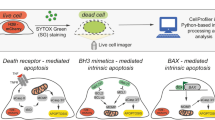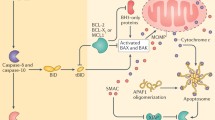Abstract
Purpose
Cancer occurs when signaling pathways become unregulated or constitutively activated inside a cell. For example, deregulation of the mitogen activated protein kinase (MAPK) pathway often leads to cancer by promoting uncontrolled cellular proliferation. Chimeric proteins can rewire these signal transduction pathways active in cancer cells by linking activation of the MAPK pathway to activation of the Fas apoptosis pathway, causing the input signal for cell proliferation to be redirected to induce cell death.
Methods
We present here a kinetic model demonstrating how these chimeric proteins can trigger apoptosis upon stimulation of the MAPK pathway. This model consists of ordinary differential equations using rate constants found in literature along with experimental data from previously published work. At a concentration of 1500 nM, the chimeric protein caused a 60% decrease in MAPK activation, causing the cell to transition from a proliferative state to an apoptotic state, validating previous experimental observations. Even at much lower concentrations (e.g. 24 nM), the apoptosis pathway is activated, so the model suggests that cell death may occur even without a direct suppression of the proliferation pathway.
Results and Conclusions
We have developed a quantitative model of caspase activation and its effect on the MAPK pathway in the presence of a chimeric protein, providing insight into a potential mechanism for reprogramming cancer cells.





Similar content being viewed by others
Abbreviations
- Csp8:
-
Procaspase-8
- Csp*:
-
Activated caspase-8
- DED:
-
Death-effecter domain
- EGF:
-
Epidermal growth factor
- EGFR:
-
Epidermal growth factor receptor
- EGFR-Csp8:
-
Phosphorylated EGF ligand and EGFR complex with Csp8 bound
- EGFR-P:
-
Phosphorylated EGF ligand and EGFR complex
- EGFR-PD:
-
Phosphorylated EGF ligand and EGFR complex with PTD-DED bound
- FADD:
-
Fas-associated protein with death domain
- LMP1:
-
Latent membrane protein 1
- LR:
-
Ligand receptor complex
- MAPK:
-
Mitogen-activated protein kinase
- MOI:
-
Multiplicity of infection
- NGF:
-
Nerve growth factor
- PI3 K-Akt:
-
Phosphoinositide 3-kinase-RAC-alpha serine/threonine-protein kinase
- PKC:
-
Protein kinase C
- PMA:
-
Phorbol-12-myristate-13-acetate
- PTB:
-
Phosphotyrosine binding
- PTB-DED:
-
Chimeric protein utilizing phosphotyrosine binding (PTB) domain and death-effecter domain (DED)
- RTKs:
-
Receptor tyrosine kinases
- Shc:
-
Src homoloy 2 domain
- TEVP:
-
Tobacco etch virus protease
References
Dhillon, A. S., et al. (2007). MAP kinase signalling pathways in cancer. Oncogene,26(22), 3279.
Blume-Jensen, P., & Hunter, T. (2001). Oncogenic kinase signalling. Nature,411(6835), 355–365.
Pearson, G., et al. (2001). Mitogen-activated protein (MAP) kinase pathways: regulation and physiological functions. Endocrine Reviews,22(2), 153–183.
Howard, P. L., et al. (2003). Redirecting tyrosine kinase signaling to an apoptotic caspase pathway through chimeric adaptor proteins. Proceedings of the National Academy of Sciences United States of America,100(20), 11267–11272.
Ashkenazi, A., & Dixit, V. M. (1998). Death receptors: Signaling and modulation. Science,281(5381), 1305–1308.
Brightman, F. A., & Fell, D. A. (2000). Differential feedback regulation of the MAPK cascade underlies the quantitative differences in EGF and NGF signalling in PC12 cells. FEBS Letters,482(3), 169–174.
Marshall, C. J. (1995). Specificity of receptor tyrosine kinase signaling: Transient versus sustained extracellular signal-regulated kinase activation. Cell,80(2), 179–185.
Kreeger, P. K., & Lauffenburger, D. A. (2010). Cancer systems biology: A network modeling perspective. Carcinogenesis,31(1), 2–8.
Anderson, A. R., et al. (2006). Tumor morphology and phenotypic evolution driven by selective pressure from the microenvironment. Cell,127(5), 905–915.
Haeno, H., et al. (2009). A progenitor cell origin of myeloid malignancies. Proceedings of the National Academy of Sciences United States of America,106(39), 16616–16621.
Altrock, P. M., Liu, L. L., & Michor, F. (2015). The mathematics of cancer: integrating quantitative models. Nature Reviews Cancer,15(12), 730.
Willerth, S. M., & Sakiyama-Elbert, S. E. (2009). Kinetic analysis of neurotrophin-3-mediated differentiation of embryonic stem cells into neurons. Tissue Engineering Part A,15(2), 307–318.
Aksan, I., & Kurnaz, M. L. (2003). A computer-based model for the regulation of mitogen activated protein kinase (MAPK) activation. Journal of Receptor and Signal Transduction Research,23(2–3), 197–209.
Maly, I. V., Wiley, H. S., & Lauffenburger, D. A. (2004). Self-organization of polarized cell signaling via autocrine circuits: Computational model analysis. Biophysical Journal,86(1 Pt 1), 10–22.
Kholodenko, B. N., et al. (1999). Quantification of short term signaling by the epidermal growth factor receptor. Journal of Biological Chemistry,274(42), 30169–30181.
Yamada, S., Taketomi, T., & Yoshimura, A. (2004). Model analysis of difference between EGF pathway and FGF pathway. Biochemical and Biophysical Research Communications,314(4), 1113–1120.
Chen, W. W., et al. (2009). Input-output behavior of ErbB signaling pathways as revealed by a mass action model trained against dynamic data. Mol Syst Biol,5, 239.
Neumann, L., et al. (2010). Dynamics within the CD95 death-inducing signaling complex decide life and death of cells. Molecular Systems Biology,6, 352.
Bentele, M., et al. (2004). Mathematical modeling reveals threshold mechanism in CD95-induced apoptosis. Journal of Cell Biology,166(6), 839–851.
Hua, F., et al. (2005). Effects of Bcl-2 levels on Fas signaling-induced caspase-3 activation: molecular genetic tests of computational model predictions. Journal of Immunology,175(2), 985–995.
Lauffenburger, D. A., & Linderman, J. J. (1993). Receptors: Models for binding, trafficking, and signalling (p. 361). New York: Oxford University Press.
Li, S. C., et al. (1996). Characterization of the phosphotyrosine-binding domain of the Drosophila Shc protein. Journal of Biological Chemistry,271(50), 31855–31862.
He, Y. Y., Huang, J. L., & Chignell, C. F. (2006). Cleavage of epidermal growth factor receptor by caspase during apoptosis is independent of its internalization. Oncogene,25(10), 1521–1531.
Bae, S. S., et al. (2001). Proteolytic cleavage of epidermal growth factor receptor by caspases. FEBS Letters,491(1–2), 16–20.
Pritalas, C. A., & Solit, D. B. (2010). Targeting the mitogen-activated protein kinase pathway: physiological feedback and drug response. Clinical Cancer Research,16(13), 3329–3334.
Gao, Q., et al. (2018). Driver fusions and their implications in the development and treatment of human cancers. Cell Reports,23, 227–238.
Acknowledgements
The authors would like to thank to Dr. Satoshi Yamada and colleagues for supplying us with the equations and parameters for their model as well as Dr. Perry Howard for many helpful conversations, insights and direction. This work was supported by an NSERC URSA award (RS), NSERC Discovery Grants (RE and SMW), and the Canada Research Chairs program (SMW).
Author information
Authors and Affiliations
Corresponding author
Electronic supplementary material
Below is the link to the electronic supplementary material.
Rights and permissions
About this article
Cite this article
Schmitz, R.M., Willerth, S.M., van Rensburg, G. et al. Quantitative Analysis of the Rewiring of Signaling Pathways to Alter Cancer Cell Fate. J. Med. Biol. Eng. 40, 41–52 (2020). https://doi.org/10.1007/s40846-019-00489-4
Received:
Accepted:
Published:
Issue Date:
DOI: https://doi.org/10.1007/s40846-019-00489-4




